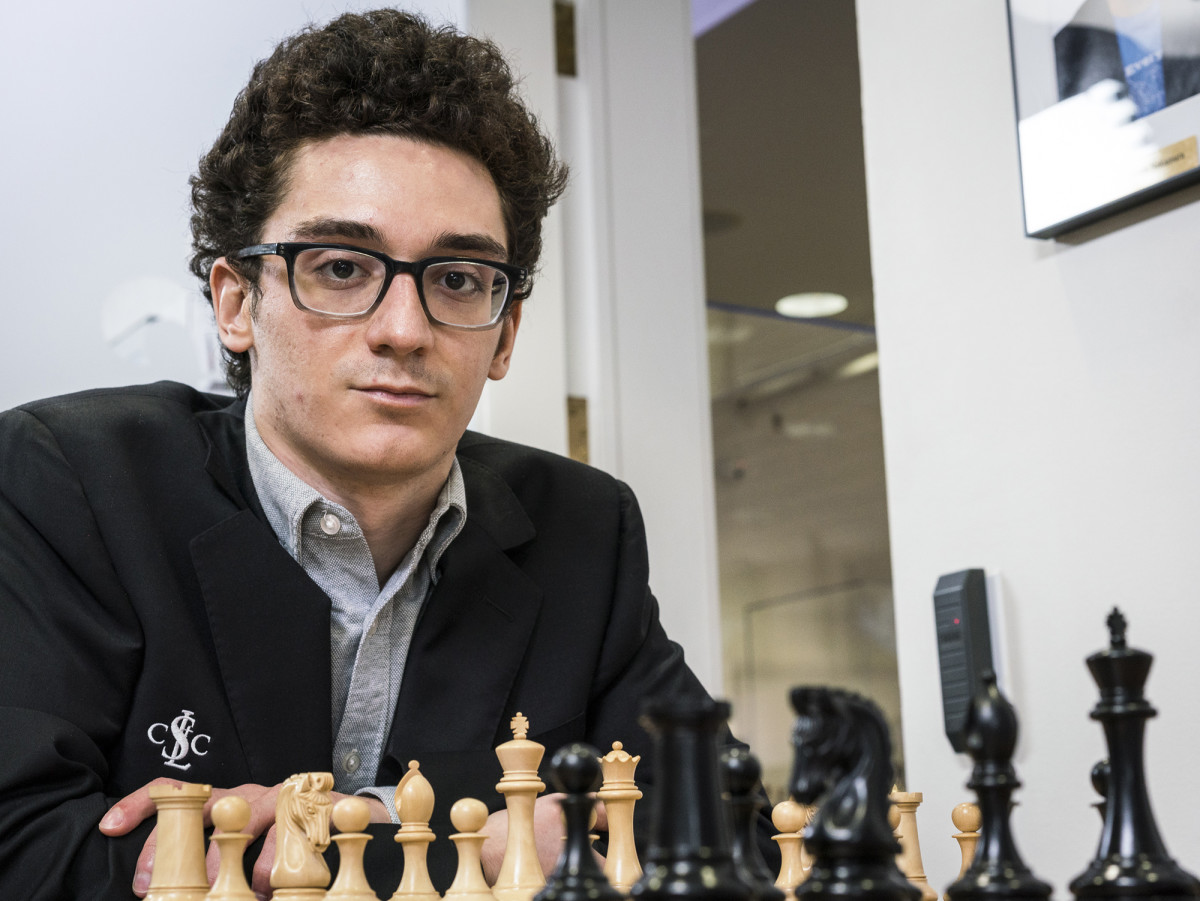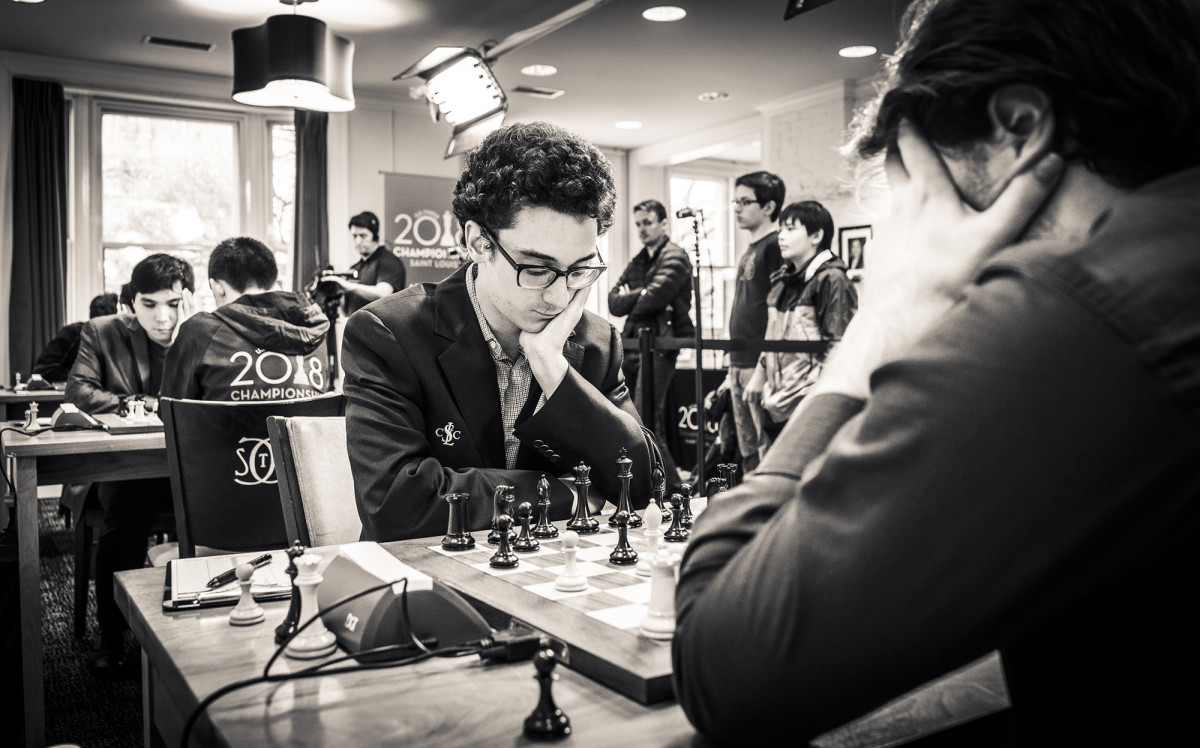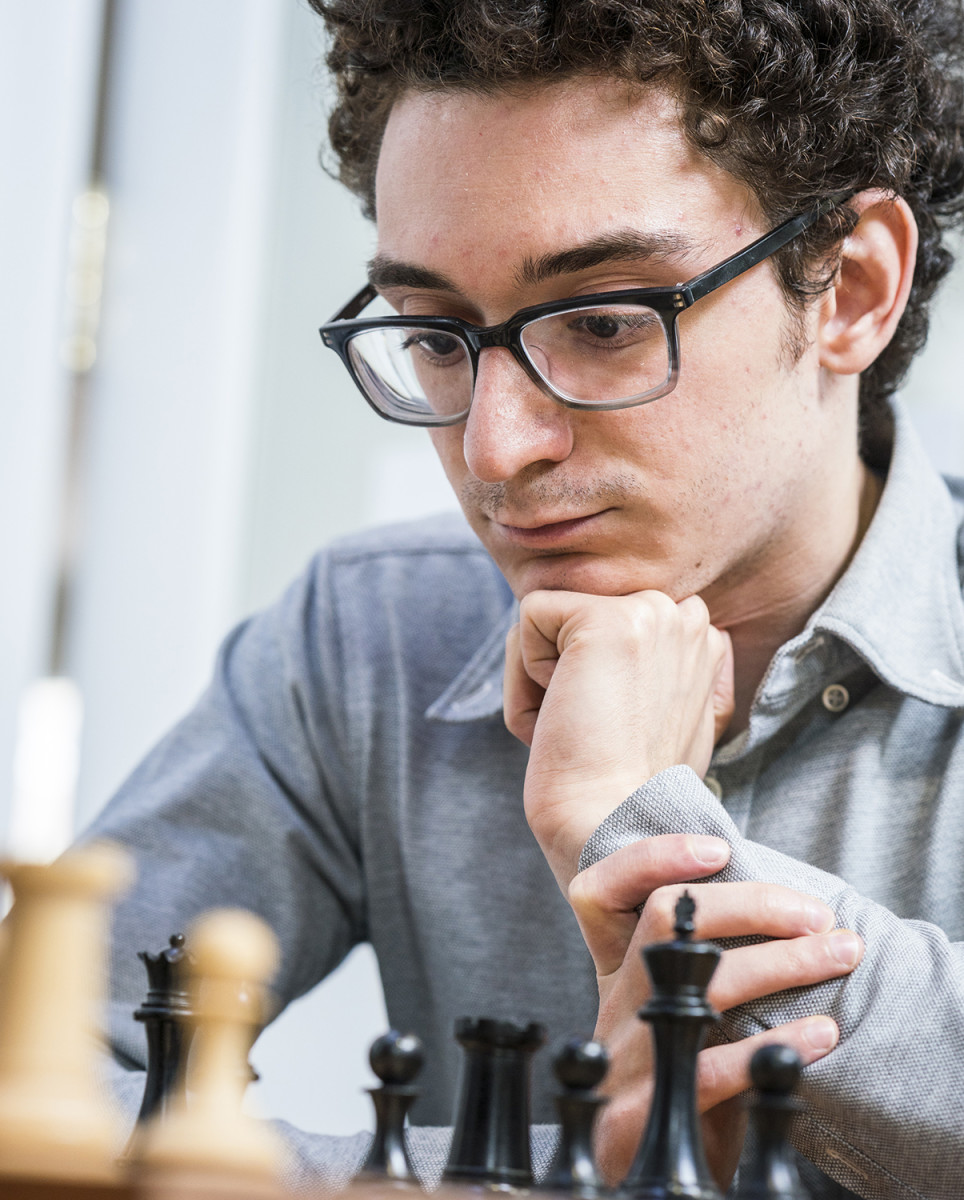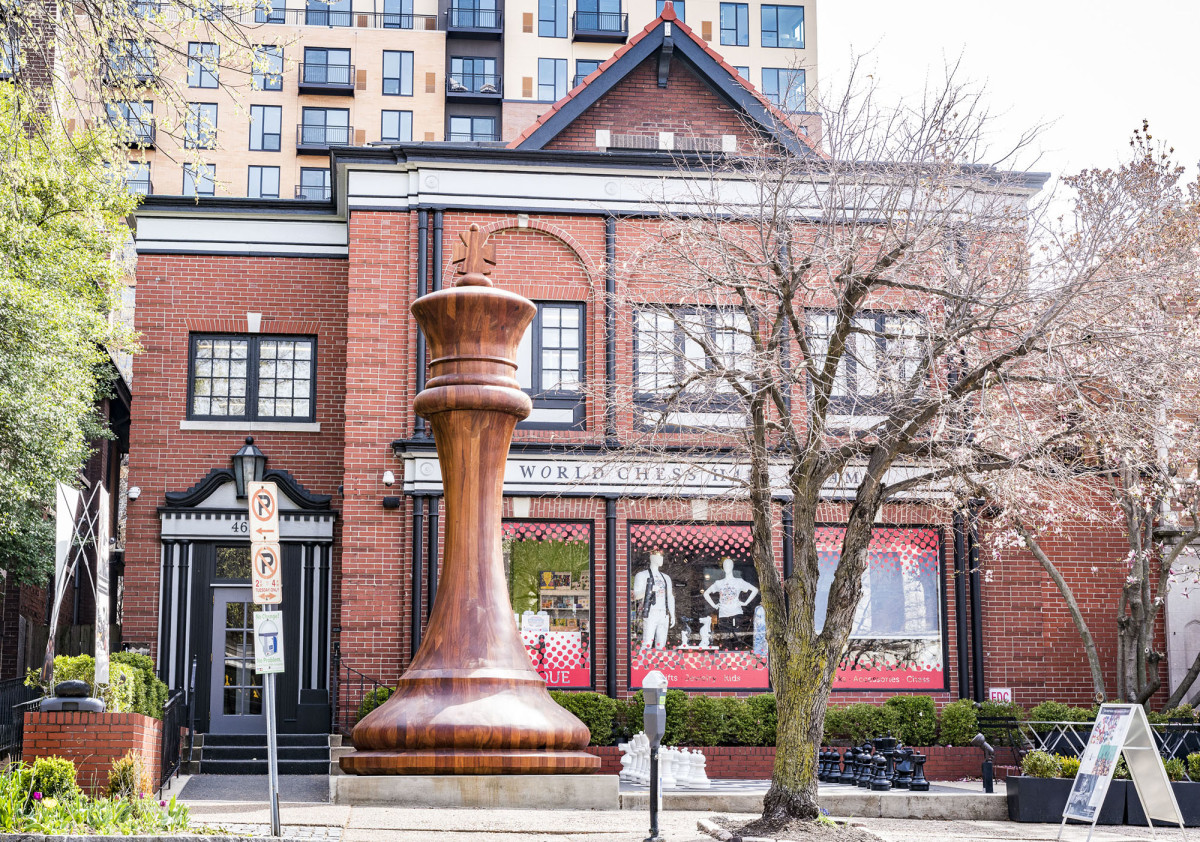America's Chance at Chess Dominance Is in the Hands of One Young Player

Start a free seven-day trial of SI TV today to see watch the full feature on Fabiano Caruana and the U.S. Chess team, along with other in-depth interviews and features on the biggest names in sports.
If America’s descent into chess oblivion began with Bobby Fischer’s decline and disappearance from the scene, then its ascent into a chess renaissance starts with Fabiano Caruana. Whereas Fischer was bombastic and incendiary, Caruana is soft-spoken and demure. Where Fischer was demanding—equally concerned with the knight mating his king as with the cameras filming his moves—Caruana is laid back. At the U.S. Chess championships in St. Louis last April, Caruana cut a decidedly unimposing figure. Tall, with thick black glasses, curly black hair, a sports jacket and a white button down, Caruana meanders between moves. He paces, one hand in his jeans pocket, one hand behind his back, stopping for a moment at other boards, striding in a nervous, yet confident, manner before returning to his seat to take a sip from his Starbucks cold brew drink. Fischer was a polyglot—Caruana watches Rick and Morty and laments the end of Key & Peele.
Despite their differences, Caruana, 26, is set up to do something that no American has done since Fischer. Because he won the Candidates Tournament in Berlin in March, Caruana will now play Magnus Carlsen for the World Championship this week in London. He is the first American to play for the undisputed title since Fischer won against Boris Spassky in 1972.
New on SI TV: Can One Kid Return the U.S. to Chess Dominance?
Caruana’s inclusion in the championship is the apex of a decade-long effort to extricate chess from The Ghost of Bobby Fischer. With his appearance in the match, Caruana is riding the coattails of an unprecedented rise in chess culture in the country. Caruana knows the legacy of Fischer is ever-present. “Every chess player in the United States in some sense lives in his shadow,” he says.
But he also knows the opportunity before him. Says the quietly confident Caruana: “My chess can stand alone.”

The resurgence of U.S. chess is not just about Caruana, the second-ranked player in the world, and his 12-game match that runs from this Friday through November 28. There are two other Americans who are ranked in the top 15 in the world, and each had legitimate chances to be in the chair across from Carlsen.
Wesley So, 25, who grew up in the Philippines and now lives in Minnesota, is ranked ninth. Hikaru Nakamura, a 30-year-old Florida resident, is ranked 13th. (Samuel Shankland, a 27-year-old Californian who won the U.S. title in April in an upset, is the next-highest-ranked American, at 29th. There are seven total Americans in the top 100.) “We have three guys that we can put up against three guys from any country,” says Joel Benjamin, a grandmaster and a three-time U.S. champion. The U.S. won the Chess Olympiad in Azerbaijan in 2016, the first time they did that since 1976. “The U.S. team is simply one of the best in the world,” says Maurice Ashley, another grandmaster and a noted chess commentator.
After Fischer backed out of the 1975 championship because he disagreed with the game’s formatting, U.S. chess fell off the map. Fischer and his various outbursts were routinely covered (see “Grandmaster Trash” in 2005 in Sports Illustrated) but stories about the sport itself were few and far between. There would be the occasional “next Bobby Fischer” column (SI wrote one about Nakamura in 2001, with the subtitle “Only 14, Hikaru Nakamura is the best young U.S. player since Bobby Fischer” ); the book Searching for Bobby Fischer, published in 1988, detailing the rise of child prodigy Josh Waitzkin, was turned into a popular movie in 1993. But the idea of someone actually becoming Bobby Fischer was impossible. We spent more time searching for him than finding his actual successor. “There hasn’t been anyone close to being in the world championship,” says Ken Rogoff, an economist at Harvard and a grandmaster. “There hasn’t been anyone knocking on the door. We’ve hardly ever had a player in the top 10 besides Fischer.”
In true American fashion, the way to a chess comeback has come via the checkbook. Any player can transfer his chess allegiance, provided a fee is paid from the acquiring federation to the original country. The U.S., from 2000–2017, paid for, or helped facilitate, 89 transfers, nearly double any other nation. In 2015, So transferred to the U.S. from the Philippines, for 5,000 euros. (So has said he paid the fee out of his own pocket.) Caruana, though born in Miami and raised in Brooklyn, moved to Europe at age 12 for better competition and training. He played for the Italian team from 2005–15, but a payment of $61,000 changed that. Caruana was also reportedly offered $400,000 by the Azerbaijanis. But America was where he wanted to be. “So many exciting things were happening in the U.S. that I really wanted to be a part of that,” he says. “And I’ve always felt like an American.”
This purchasing of players has been mocked by The Daily Show (“The United States is buying up nerds!” Jon Stewart cracked. “Nerd mercenaries!”) and even Carlsen, who, in a tweet, wrote: “Wonderful fifth place for our young team at the chess olympiad, so proud of my teammates!! Probably need an even better squad to go further though, wonder if Caruana and So are still for sale.”
But the reason—money aside—that these nerd mercenaries are coming to the U.S. stems from the work of one man.

Down a private gated road in the Central West End of St. Louis, and into a large mansion, sits a house-cum-art gallery. Paintings, expertly backlit, surround the first floor, including one titled Missouri Farmer, by Joe Jones. The day’s papers are strewn about, and classical music is humming in the background. It’s all a bit Downton Abbey-ish, and you half expect Carson to come out to announce the man of the house’s arrival.
The man of the house is Rex Sinquefield, who comes out of his back office, wearing a maroon long sleeve polo with the logo of the St. Louis Chess Club on his chest, sipping a black iced coffee.
Sinquefield is the head of the Chess Club, an elegant, two-story building that opened in July 2008. The Chess Club is now the home of U.S. Chess. All national championships are played there, and the annual Sinquefield Cup hosts some of the top players in the world.
Sinquefield, 74, has a biography that belies his mansion life. Born in St. Louis, he was raised in the Saint Vincent Home for Children. He first became interested in chess at the orphanage, but didn’t learn how to play until he was 13. He’s a scratch competition player, and often has more than 20 games going at once online. His wealth, which has been rumored to be in the billions but has never been made public, came from starting Dimensional Fund Advisors, a large investment firm that pioneered index funds. Sinquefield, now retired, is a chess fanatic (he purchased Fischer’s personal library), and uses his wealth to fund his two passions—conservative politics and the game he loves.
Sinquefield has vast influence in Missouri. He runs the Show-Me Institute, a free-market think tank, which, according to its 2016 tax return, employs 20 people. The St. Louis Beacon estimated that between 2009 and 2013, he gave $28 million to state political campaigns. In 2016, Sinquefield donated more than $10 million to a variety of candidates and issue groups. (Nationally, he’s supported a wide variety of conservative politicians, such as Michelle Bachman, Steve King, Mitt Romney and Paul Ryan.)
Sinquefield is a St. Louis—and Missouri—evangelist, whether it’s chess or politics. That vision has fueled the growth of the club, both in the city and nationwide.

A few blocks from his home sits the Club. It’s part museum, part library, part competition area, part shrine—to chess history and Sinquefield himself. Situated in a tony neighborhood, replete with a Warby Parker and a Bonobos, the Chess Club is investing heavily in U.S. Chess. The 6,000-square-foot building hosts community events and lessons, and the Club is active in more than a hundred schools. The Hall of Fame is home to a plethora of Fischer paraphernalia, from the pieces in the third game of his 1972 match against Spassky, to his “red book” that listed every move by every opponent he faced. For his efforts, Sinquefield has won the Gold Koltanowski Award, which honors the person who does the most to further U.S. Chess, five times.
Outside the museum is the world’s largest chess piece, a king. Originally built at 14 feet, it was briefly supplanted by another piece in Kalmthout, Belgium, made at 16 feet. “And I said, Belgium may have put the kibosh on the Kaiser, but they’re not gonna put the kibosh on the World Chess Hall of Fame in St. Louis,” Sinquefield says. A new piece went up in April—it’s now 20 feet.

There is a bit of Sinquefield worship—the club put out a newspaper for the championship called the Sinquefield Effect. (Wrote Garry Kasparov in the lead story: “Half a world away from Moscow, Saint Louis is the true heir to the Soviet chess machine.”) There are photos of him playing chess throughout the club. Virtually every player and grandmaster, often without prompting, seems to mention the Sinquefields (his wife, Jeanne, is also heavily involved). But it’s also true that what’s been built in St. Louis is fueling chess across the country. “If you look at the chess centers around the world, you don’t have this funding, you don’t have tournaments all the time,” says Nakamura. “Rex has changed the image of chess in the U.S. A lot of people see a future where you could make a living as a chess player.”
The Center is a thriving force. More grandmasters live in St. Louis, per capita, than any other place in the world. It’s active in chess education in St. Louis and around the country. It’s made people want to play chess and play chess in America.
And it’s given people like Caruana the chance to make history.
When Caruana faces Carlsen in London for the title, he will have to do beat him in a 12-game series. (A win is worth a point, a draw is worth 1/2; Caruana needs 6 1/2 to win, while Carlsen retains the title with 6.) Carlsen, a 27-year-old Norwegian, became the World Champion in 2013, and he has defended his title in ’14 and ’16. He’s a prodigy, and he’s in the discussion for the greatest player of all time. “When all is said and done, Carlsen might make the claim to be the Michael Jordan of chess,” says Ashley. “That’s his potential. Right now, he’s not quite there. It’s kind of like Kobe Bryant trying to prove himself, or LeBron James saying, ‘I am the best of all time.’ That’s the kind of conversation people have about Magnus Carlsen.”
Carlsen is a superstar in Norway. He’s appeared in modeling campaigns for G-Star; he has his own app; was once named as one of the world’s sexiest men by Cosmopolitan; and even appeared on The Simpsons. But he’s a bit mercurial. After he agreed to an interview with SI, he began to back out upon realizing it would be on video. After a prolonged discussion with his father, Henrik, who also serves as his manager, Magnus said: “I wouldn’t have agreed to do this if I knew that it was going to be like this.” He eventually agreed to an audio interview.
But while Caruana is the underdog, he’s not out of his depths. The two have played 33 times before, and Carlsen leads the series 10 games to five. (There have been 18 draws.) Carlsen is expected to win, but Caruana has a shot to do it. “When Fabiano is in form,” says Jen Shahade, a two-time U.S. women’s champion, “he can just absolutely crush everyone. Even Magnus Carlsen.” Nakamura puts Caruana’s chances at 20%. Bruce Pandolfini, one of Caruana’s early teachers (and portrayed by Ben Kingsley in Searching for Bobby Fischer), says, “He’s not going to be cowed. He’s going to put up a real fight. It’s a really good chance [he wins].”
But whether Caruana wins is almost beside the point. His presence at the championship is such a defining accomplishment that it has the power to galvanize the sport in this country. “Caruana has simply electrified American chess in a way that no one has in decades,” says Ashley. “For him to be in this event, he’s telling all of the other players, Come on, get on my back. I’m going for it. You guys can keep growing, keep developing, because we’re making a mark on the world stage.”
Indeed, the future of U.S. chess is bright. There are a number of promising teens, from Annie Wang, a 16-year-old Californian, who finished second at the U.S. championships, to Awonder Liang, a 15-year-old from Wisconsin, who battled Caruana to a draw in the first round of the championships and, according to Ashley, “spanked” Caruana earlier this year in a rapid game.
Caruana is ready for Carlsen and, in interviews, appears calm and measured. He understands the historical significance, but he’s also competitive. He wants it for himself. “I can win the world title,” he says. “I don’t want to miss the opportunity. There’s a very strong personal desire to make the most of it and actually win the title.”

Fischer was a bona-fide superstar. He was on the covers of magazines and on talk shows. His match against Spassky in Iceland is still the most-watched competitive event in world history. The combination of Cold War Hate, his eccentricity and his utter brilliance made for must-see TV. (Says Rogoff: “He won 18 games in a row over grandmaster opposition. No one’s come close to that.”) It remains unclear as to how the country will receive a Caruana win. Surely, there won’t be an offer for a ticker-tape parade in New York City (Fischer declined his invitation for one). It’s hard to imagine Caruana on Colbert or the front page of The New York Times.
But unlike Fischer, a lone wolf in terms of talent in his homeland, Caruana is leading a real chess movement. Should Caruana falter, there are two world-class players ready to take his place. Behind them are a talented group of kids who have all reached top levels. Caruana can fall off the face of the Earth, but he won’t take U.S. chess down with him.
Caruana can’t match Fischer, both on the board and in life. The Ghost of Bobby Fischer looms. But for the first time, the specter is fading. And the present—a vibrant, glorious present—is emerging.
